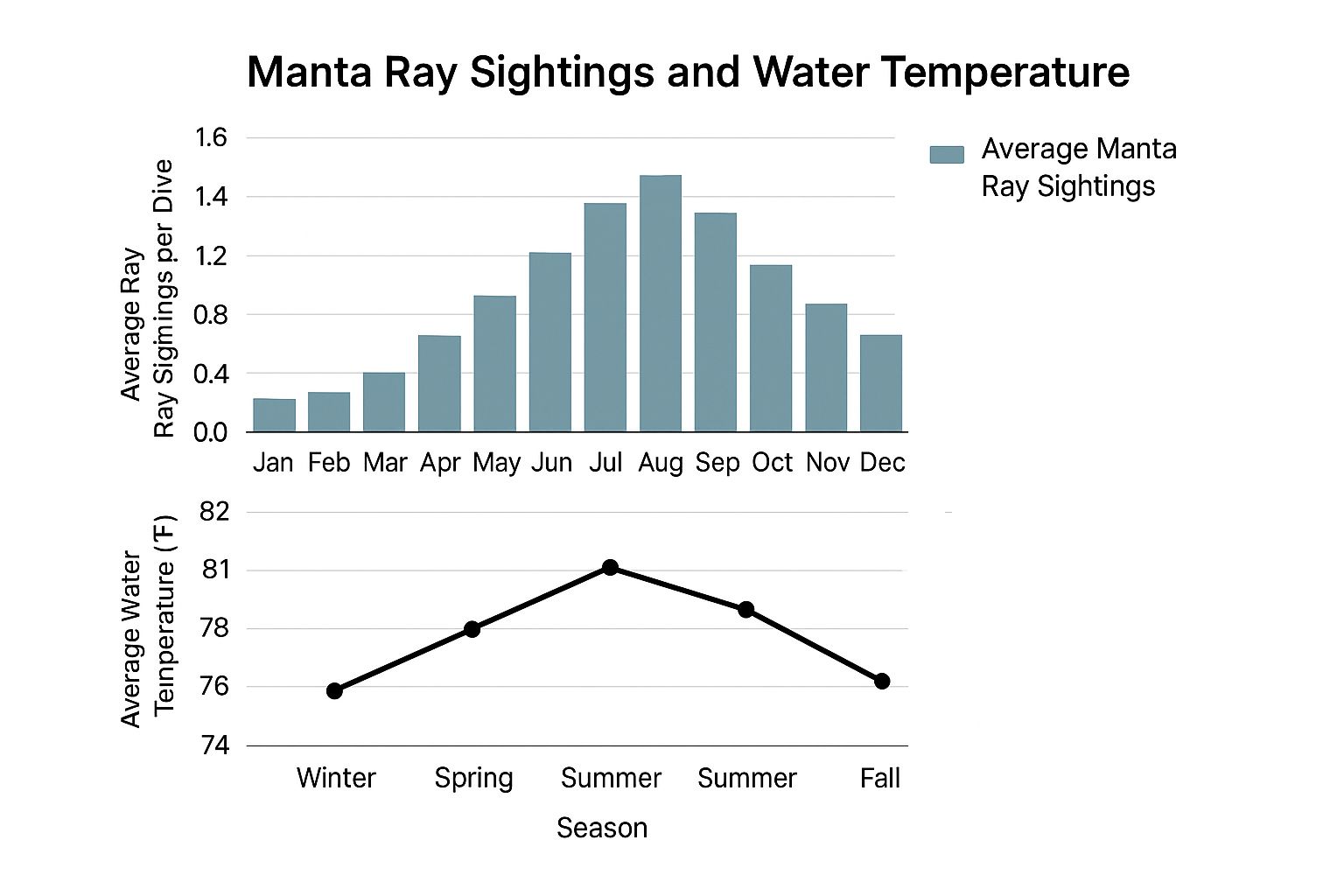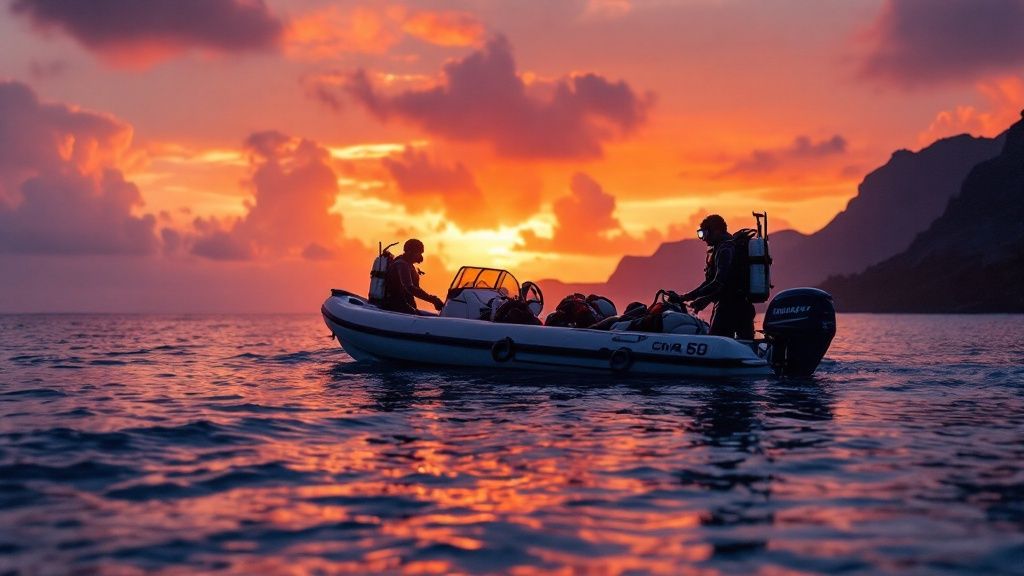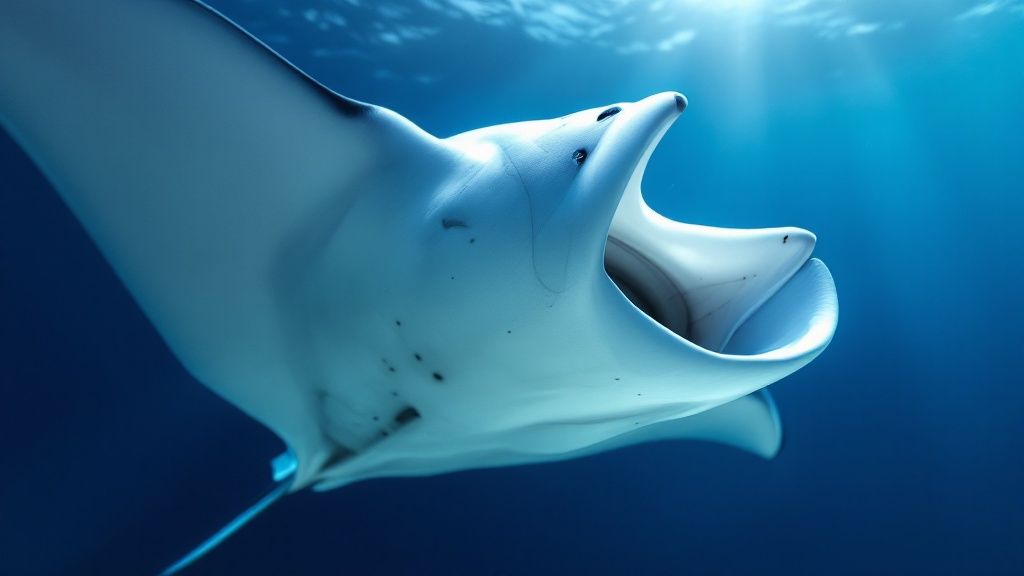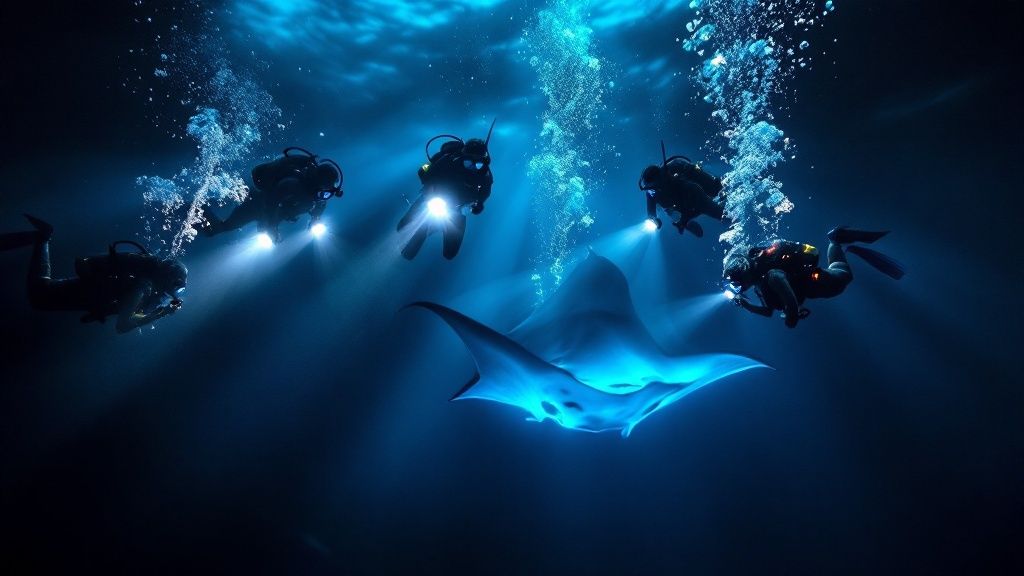Why Kona's Manta Ray Dives Are World-Renowned
Kona, Hawaii, is more than just a stunning vacation spot; it's the manta ray diving capital of the world. What makes these waters so alluring to these gentle giants, creating unforgettable dive experiences? It's a combination of nature's perfect design and thoughtful human interaction.
The Perfect Ecosystem for Manta Rays
Kona's underwater landscape plays a vital role. Volcanic slopes create deep, nutrient-rich waters near the shore, fostering plankton blooms, the manta ray's main food source. Consistent currents deliver a continuous supply of these microscopic organisms, ensuring a constant feast. This reliable food source, coupled with the clear, warm waters, makes Kona an ideal habitat. This means mantas are consistently drawn to the area, giving divers reliable sighting opportunities. Curious to learn more? Check out: Why should you go on a manta ray dive in Kona?
The "Manta Ray Village" and "Manta Heaven" Phenomenon
Kona's reputation isn't solely built on natural wonders; human ingenuity plays a part. The renowned night dives at Manta Village and Manta Heaven are enhanced by innovative lighting. These lights attract plankton, drawing the mantas closer to the surface. This creates a mesmerizing display of these graceful creatures feeding in the illuminated water. This predictable feeding pattern allows dive operators to offer nearly guaranteed encounters, cementing Kona’s place as a premier manta ray diving destination.
Tracking and Tourism: Kona's Manta Ray Success Story
The Kona Coast's manta ray diving industry has thrived thanks to detailed sighting tracking, especially between 2009-2014. Dive operators meticulously documented individual mantas during nightly dives at sites like Manta Village and Manta Heaven, identifying them by their unique belly patterns. This dedication has led to the identification of over 290 individual rays by 2023, showcasing a flourishing population. Nightly sighting success rates remain remarkably high, at 80-90%, fueled by the nutrient-rich currents that attract plankton year-round. By 2024, an estimated 80,000 people annually participate in manta snorkel/dive tours, contributing to one of Hawaiʻi's most globally recognized marine ecotourism activities. For a deeper dive into these statistics, look here.
Visualizing Kona's Manta Ray Magic
The following data chart visually represents key data on manta ray sightings in Kona:

This chart demonstrates the impressive consistency of manta ray sightings. It shows that even during the off-season, sighting rates remain remarkably high, around 75-80%. Peak season boasts success rates exceeding 95%. The chart also reveals that an average of 5-10 mantas are seen per dive during peak season, creating a truly unforgettable spectacle.
To further understand the thriving ecosystem, let's examine the monthly success rates at popular dive sites. The following table provides detailed information on sighting success, average manta counts, and optimal viewing times.
Manta Ray Sighting Success Rates in Kona
| Month | Success Rate (%) | Average Number of Mantas Seen | Peak Viewing Times |
|---|---|---|---|
| January | 90 | 8 | Sunset – 9 PM |
| February | 95 | 10 | Sunset – 9 PM |
| March | 92 | 9 | Sunset – 9 PM |
| April | 88 | 7 | Sunset – 9 PM |
| May | 85 | 6 | Sunset – 9 PM |
| June | 80 | 5 | Sunset – 9 PM |
| July | 78 | 5 | Sunset – 9 PM |
| August | 75 | 4 | Sunset – 9 PM |
| September | 82 | 6 | Sunset – 9 PM |
| October | 89 | 7 | Sunset – 9 PM |
| November | 93 | 9 | Sunset – 9 PM |
| December | 95 | 10 | Sunset – 9 PM |
This table clearly illustrates the high probability of encountering manta rays throughout the year in Kona, with peak months offering exceptional opportunities to witness these magnificent creatures. The consistency of high success rates and the impressive number of mantas seen per dive solidifies Kona's position as a world-class manta ray destination. Practicing good communication is vital for responsible diving and conservation, especially for remote dive teams. For more insights on remote team communication, check out these remote team communication tips.
The Magnificent Mantas of Kona: Personalities & Patterns

Manta ray dives in Kona offer a unique opportunity: the chance to connect with these gentle giants on an individual level. Unlike fleeting glimpses of wildlife, Kona's mantas are identifiable, each possessing unique markings and even distinct personalities, making each encounter truly special. This personal connection elevates the already incredible experience of diving with these graceful creatures.
Nature's Fingerprints: Identifying Kona's Mantas
Researchers and local dive operators use the unique ventral patterns on the underside of each manta ray to track them. These markings, much like human fingerprints, allow for long-term monitoring and study of individual mantas. This careful tracking provides valuable insights into their social behaviors and migratory routes.
This identification system also means divers can recognize familiar mantas upon return visits, fostering a sense of connection with these ocean giants.
Famous Faces: Big Bertha and Lefty
Some Kona mantas have achieved local celebrity status. Big Bertha, known for her impressive size and gentle demeanor, has graced Kona's waters for decades. Lefty, the first manta officially cataloged in the area, marks the beginning of Kona's detailed tracking program, paving the way for ongoing research and crucial conservation efforts. These well-known individuals highlight the longevity and site fidelity of Kona's manta population, establishing a profound bond between these gentle giants and the local community. Learn more about these incredible creatures at Manta Ray Heaven – Garden Eel Cove.
A Deeper Dive Into Kona's Manta Species
Kona's manta ray population comprises two distinct species: the reef manta (Mobula alfredi) and the giant oceanic manta (Mobula birostris). While both are present, reef mantas are the stars of most coastal dives, particularly in popular spots like Manta Village and Manta Heaven.
To illustrate the key differences between these two magnificent species, the following table provides a comparative overview.
To better understand the distinctions between these two species, let's explore their unique characteristics in a comparative table.
| Characteristic | Reef Manta (Mobula alfredi) | Giant Oceanic Manta (Mobula birostris) |
|---|---|---|
| Size | 12-18 ft wingspan | Up to 22 ft wingspan |
| Coloration | Dark dorsal side with distinct markings | Dark dorsal side with less distinct markings |
| Mouth Color | White | Black with white patches |
| Feeding Behavior | Often feeds in shallow coastal waters | Typically feeds in deeper oceanic waters |
| Distribution | Found closer to shore, around reefs and islands | More pelagic, often found in open ocean |
| Sighting Frequency in Kona | More frequently sighted | Less frequently sighted |
Data from 2013 reveals impressive sighting numbers, ranging from 50-150 per dive location each month, underscoring the abundance of reef mantas in these areas. Some individuals, like Big Bertha, have been returning to these feeding grounds for decades, demonstrating strong site fidelity. The combination of cold upwellings and artificial light from dive tours creates predictable feeding opportunities, which has greatly facilitated the documentation of individual rays' movements. For more fascinating facts about manta rays, see here. This consistent presence allows researchers and divers alike to gain valuable insights into the lives of these incredible animals.
Planning Your Perfect Kona Manta Experience
Planning a trip to Hawaii? Why not transform your vacation into something truly unforgettable with a Kona manta ray dive? But before you grab your fins and snorkel, some careful planning is essential. Choosing the right operator, understanding pricing, and considering seasonal variables can significantly impact your experience. This guide provides you with the key considerations to ensure a magical encounter.
Choosing the Right Operator for Your Manta Ray Dive Kona Adventure
Selecting a reputable manta ray dive Kona operator is paramount to a positive experience. Look for operators dedicated to sustainable tourism practices, such as those previously listed on the Manta Ray Green List. Prioritizing operators who emphasize manta ray safety and responsible interaction guidelines ensures your experience contributes to the well-being of these gentle giants. Smaller group sizes often provide more personalized attention and a less crowded in-water encounter, so consider this factor as well.
Snorkeling vs. Diving: Which Manta Experience Is Right for You?
Choosing between snorkeling and diving depends on your comfort level in the water and any certifications you may hold. Snorkeling offers the chance to witness mantas from the surface while holding onto a flotation device. Scuba diving, on the other hand, demands certification but provides a closer, more immersive perspective. Divers typically sit on the ocean floor, looking up as the mantas gracefully feed above. Weigh your experience level and desired proximity to the mantas to make the best choice.
Timing Your Dive: Day vs. Night Manta Encounters
Night dives are the quintessential Kona manta experience. The artificial lights used attract plankton, creating a captivating "campfire" effect that draws mantas in for feeding. Some operators also offer daytime encounters, which provide a unique perspective on manta ray behavior. While daytime sightings can be less predictable than night dives, they can still be incredibly rewarding. Research operator offerings for both day and night options to see which best suits your preferences.
Gear Up for Success: Enhancing Your Manta Ray Dive
While operators provide basic equipment, a few additions can truly enhance your manta ray dive. A high-quality dive light improves visibility and helps attract plankton during night dives. An underwater camera, particularly one designed for low-light conditions like a GoPro, allows you to capture stunning images and videos. Finally, a comfortable wetsuit keeps you warm, enabling you to fully immerse yourself in the experience without distraction.
Asking the Right Questions: Preparing for Your Kona Manta Adventure
Before booking your manta ray dive Kona excursion, asking the right questions can make all the difference. Inquire about the operator’s experience, group size, and commitment to sustainable practices. Understanding cancellation policies and contingency plans in the rare event of no manta sightings is also important. Thorough preparation ensures a smooth and enjoyable experience, allowing you to fully appreciate these magnificent creatures.
Day vs. Night: When To Experience Kona's Mantas

Manta ray encounters in Kona, Hawaii, offer two distinctly different experiences: day and night dives. Each provides a unique perspective on these gentle giants, promising an unforgettable memory regardless of your choice. But how do you decide which is right for you? This section will highlight the characteristics of each, helping you plan the perfect manta ray dive adventure in Kona.
The Magic of Night Dives: Kona's Signature Manta Experience
Kona's night dives are renowned for manta ray encounters, and for good reason. The experience centers around a captivating interplay of nature and human innovation. Divers assemble on the ocean floor, shining their dive lights upwards to create the “campfire” formation. This artificial light attracts plankton, the manta ray's main food source.
As the plankton gathers, so do the mantas, resulting in a mesmerizing display of graceful giants feeding just above you. This reliable feeding behavior makes night dives the most consistent method for witnessing these incredible creatures up close.
This predictability leads to incredibly high sighting rates, often over 90%. This virtually guarantees a magical encounter with these gentle giants. Watching these massive creatures glide effortlessly through the illuminated water is truly awe-inspiring.
Daytime Encounters: A Different Perspective on Manta Rays
While night dives are king in Kona, daytime encounters offer a different kind of magic. During the day, mantas are occasionally spotted feeding or being cleaned at specific sites, although these sightings are less predictable than night dives. However, for those who prefer exploring Kona's waters under natural sunlight, daytime provides a chance to witness these creatures in a new light.
Their behavior varies between day and night, offering unique observation opportunities for the attentive diver. Daytime encounters may also appeal to underwater photographers who prefer natural light. The clear, sunlit water creates a vibrant setting for capturing these graceful creatures in their natural environment.
Photographic Opportunities: Day vs. Night
Both day and night dives offer distinct advantages for underwater photography. Night dives allow you to capture the dramatic contrast of mantas against the dark water, illuminated by dive lights, creating ethereal and unforgettable images. Daytime dives, on the other hand, allow you to capture the vibrant colors of the mantas and the surrounding reef in natural light.
Ultimately, the best choice depends on your photographic style and preferences. Do you prefer the drama of darkness or the vibrancy of natural light? Consider this when making your decision.
Behavioral Observations and Emotional Impact
Whether you opt for a day or night dive, witnessing these gentle giants in their natural habitat is a profound experience. You might be interested in learning more about the ideal time of year for manta ray dives: Learn more about the best time of year to dive with mantas.
The sheer size and grace of manta rays inspires awe and wonder, a feeling that stays with you long after you resurface. Whether captivated by their feeding ballet under the lights of a night dive, or observing their natural behaviors during the day, a manta ray dive in Kona will undoubtedly leave a lasting impression.
The Manta Ray Dive Experience: From Entry to Encounter

From the initial briefing to that first plunge into the dark Pacific waters, a manta ray dive in Kona is an experience brimming with anticipation. This section will walk you through the journey, from pre-dive jitters to the breathtaking moment you encounter these gentle giants, offering practical tips and insights from both novice and seasoned divers.
Preparing for the Dive: Briefing and Expectations
Your manta ray adventure begins with a thorough briefing. This vital step covers everything from proper in-water etiquette to essential safety procedures. Pay close attention as your dive guide explains responsible interaction with the manta rays, emphasizing respectful observation. They will also cover current management, maintaining neutral buoyancy, and what to expect in the unique sensory environment of a night dive. For instance, they'll explain the importance of keeping a safe distance and not touching these magnificent creatures. This lays the groundwork for a safe and enriching experience for both divers and the manta rays themselves.
Entering the Water and the Descent
Entering the water, the shift from the boat's warm light into the cool, dark ocean can be exhilarating, perhaps even a little intimidating. Your dive guide will lead you to the designated viewing area, often near the ocean floor for divers. This provides an ideal vantage point, allowing you to look up and witness the mantas gracefully gliding above. One decision you'll face is whether to experience Kona's mantas during the day or at night. You might consider a Kona Manta Ray Night Snorkel. Maintaining neutral buoyancy is crucial. It allows you to stay still and avoid disturbing the sandy bottom or any coral formations. This controlled descent prepares you for the highlight of the dive: the manta ray encounter.
The Manta Ray Encounter: Awe and Wonder
And then, the magic unfolds. Enormous, winged shadows emerge from the depths, their movements fluid and captivating. The thrill can be intense, making steady breathing even more important. Picture a silent ballet performance before your eyes, the mantas looping and spiraling as they feed on the plankton attracted by the dive lights. By positioning yourself respectfully, you can enjoy close encounters without interfering with their natural behavior. While capturing photos or videos is tempting, remember to prioritize the well-being of the mantas. Minimize your equipment use and allow them to approach you. For further information, see Our guide on Kona manta ray night dives. This considerate approach enhances the experience for all.
Post-Dive Euphoria and Reflection
As you ascend and climb back onto the boat, a wave of euphoria washes over you. The encounter often becomes a truly memorable moment of any Hawaiian adventure, leaving divers with a profound appreciation for the ocean's wonders. This special experience fosters a deeper understanding of these majestic creatures and the crucial role of protecting their delicate ecosystem. Post-dive conversations buzz with shared excitement and a sense of awe, cementing the memory of this magical encounter.
Ethical Encounters: Conservation & Responsible Diving
Diving with manta rays in Kona is an incredible experience, but it’s important to remember our responsibility towards these gentle giants. Sustainable manta tourism plays a vital role in both research and conservation, providing a model for ethical interactions with wildlife. This section explores how you can contribute to these crucial efforts while enjoying an unforgettable underwater adventure.
Recognizing Responsible Tour Providers
Choosing the right manta ray dive Kona operator is the first step towards ethical diving. Look for operators actively committed to sustainable practices. While the Manta Ray Green List is no longer active, inquiring about an operator's conservation efforts, adherence to interaction guidelines, and support for research initiatives can help you identify truly responsible providers. For example, ask about group sizes. Smaller groups often mean less disruption to the mantas and their environment, ensuring your trip directly benefits the very creatures you came to see.
Protecting Mantas and Their Habitat
Responsible diving practices safeguard both the manta rays and their delicate ecosystem. Never touch a manta ray. Their skin is covered in a protective mucus layer that can be damaged by human contact. This simple yet critical guideline prevents potential harm to these magnificent animals. Maintaining neutral buoyancy as a diver minimizes the risk of accidental contact with the ocean floor or coral, preserving the delicate underwater landscape.
Visitor Participation in Research
Your manta ray dive Kona experience can contribute directly to scientific understanding. Many operators collaborate with researchers, collecting data on manta ray populations, behaviors, and health. Some even invite guests to participate in identification efforts by sharing photos of the mantas' unique ventral patterns. These citizen science initiatives turn tourists into active participants in conservation efforts. By participating in these programs, a vacation highlight becomes meaningful marine conservation action. This collaborative approach strengthens the link between tourism and conservation, ensuring a sustainable future for manta rays in Kona.
Advocating for Manta Rays: Beyond the Dive
Conservation doesn't end when your dive does. Become an advocate for manta rays long after you return home. Share your experience with others, raising awareness about the importance of responsible manta tourism. Support organizations dedicated to marine conservation and educate yourself on the ongoing challenges facing these incredible creatures. You might be interested in learning more about the regulations surrounding manta rays in Kona: Learn more in our article about the regulations surrounding manta rays in Kona. Every action, no matter how small, contributes to a larger movement striving to protect these gentle giants for future generations. This transforms a fleeting vacation memory into a lasting positive impact.
Experience the magic of manta rays responsibly with Kona Honu Divers. We are committed to sustainable practices and ethical wildlife interactions, ensuring your adventure contributes to the conservation of these magnificent creatures. Book your unforgettable manta ray dive Kona experience today!
